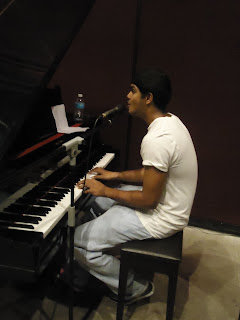The three pieces I practiced for my Grade 6 Piano exam were:
- Courante: third movement from Suite in C, K. 399/385i (Mozart)
- Adagio: second movement from Sonata in C, WoO 51 (Beethoven)
- Jazz Exercise No. 2: from Jazz Piano for the Young Pianist, Vol. 3 (Peterson)
Courante is played at a moderate speed and included a lot of chords which I had to play over and over again several times to familiarize myself with them. It also had to be played with some feeling although it was difficult to determine the dynamics of the piece as performance directions were not available. I had to rely on my teachers advice and the CD I bought which had all pieces played by professionals.
Adagio is a longer, gentle piece that’s played slowly with an incredible amount of feeling. What I found difficult was playing the left hand softly while simultaneously bringing out the right hand by applying more pressure on the keys. The dynamics here were very precise but I had trouble maintaining a steady slow pace, especially when I grew more confident about my notes.
The Jazz piece is undoubtedly my favorite of the three. I loved the modern, playful touch it had and it was a change from all exam pieces I’ve played in the past. It required a lot of power to play the notes as well as speed and dexterity.
In addition to this I had to master all major and minor scales, 2 staccato scales, 2 contrary motion scales, C major in thirds, chromatic scales and arpeggios. Admittedly, the large amount of scales does get rather monotonous at times although they help a great deal in familiarizing me with the geography of the piano and key signatures. There is also a sight reading test where the examiner would present me with a short unseen extract of music and ask me to play it at sight: this requires a lot of practice as this is my weak point.
Aural tests are included as well such as pitching, singing at sight, clapping a tune and determining the time all of which I was comfortable with. The challenge lay in identifying a particular piece’s composer and the period in which it was written. As I go to an international school I was not taught this section of theory as they do in local schools so I had to take a crash course! I realized that each period’s music has their own tell-tale characteristics that helped me identify them. For instance, the Romantic Period’s music is played with a lot of feeling, Modern Period’s ones have erratic chord changes and chromic scale features, the Baroque style has one part playing against the other while the Classical pieces have pleasant tunes.
On the day of the exam, I was nervous but quite confident about myself. All my scales but one were played flawlessly so that practice did pay off! Courante went well but I broke down in Adagio and had to start again! Thankfully, the Jazz piece was a lot better. I played the sight reading steadily enough and the aural tests went well although I wasn’t completely confident about my answers. I left with a sigh of relief: the small room with the unfamiliar piano is quite unnerving but my teacher reassured me it went well.
I passed with merit J







